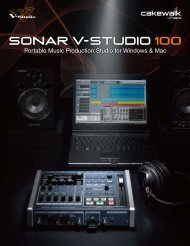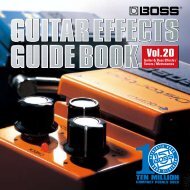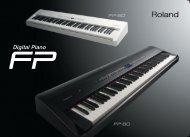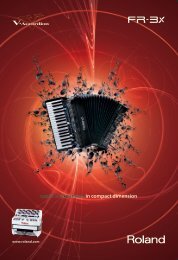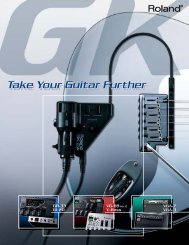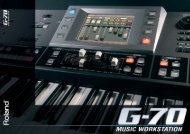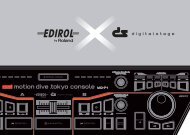OCTA-CAPTURE Technology Overview - Roland
OCTA-CAPTURE Technology Overview - Roland
OCTA-CAPTURE Technology Overview - Roland
Create successful ePaper yourself
Turn your PDF publications into a flip-book with our unique Google optimized e-Paper software.
<strong>Technology</strong> <strong>Overview</strong><br />
AUTO-SENS automatically sets the input level for each channel<br />
Setting optimum recording levels is an indispensable part of capturing high-quality<br />
recordings. If input levels are too high, the sound will distort; if levels are too low, you lose<br />
the advantage of the excellent resolution afforded by digital recording, and the sound suffers<br />
from signal-to-noise ratio deterioration. To solve these issues, <strong>OCTA</strong>-<strong>CAPTURE</strong> is equipped<br />
with a newly developed “AUTO-SENS” function, which makes it quick and easy for even<br />
novice users to set the optimum level for a particular sound source. With AUTO-SENS, all<br />
you have to do is press a button, supply sound input, and the built-in DSP will analyze the<br />
sound and set the optimum input level. In addition to Manual mode, where the DSP begins<br />
analyzing when you press the button and stops when you press it again, you can also<br />
define a preset analysis time of 30 seconds, 1 minute, 3 minutes, or 5 minutes. This<br />
revolutionary function is a real time-saver in recording sessions where setup time is limited.<br />
High-performance DSP onboard with support for four discrete mixes<br />
With <strong>OCTA</strong>-<strong>CAPTURE</strong> and its high-performance DSP boasting 40-bit internal processing<br />
capability, you can use up to four digital mixers in two different categories (input mixer and<br />
output mixer) without tasking your PC. With these “direct mixers,” you’re able to directly<br />
output any connected source without routing it through your DAW program, and also tweak<br />
your sounds using <strong>OCTA</strong>-<strong>CAPTURE</strong>’s built-in digital reverb and compressor. You can<br />
provide four independent latency-free mixes for performers, with different source volumes<br />
and dry-wet balances to suit the preferences of each musician. Each digital mixer also<br />
features a patch bay, which allows you to route your outputs for various applications and<br />
save these settings on your PC.<br />
VS Streaming achieves extreme low-latency recording<br />
<strong>OCTA</strong>-<strong>CAPTURE</strong> embodies the ideal vision of next-generation audio interfaces, and<br />
<strong>Roland</strong>’s latest “VS Streaming” audio-streaming technology is another feature that<br />
underscores its exceptional advantage. <strong>OCTA</strong>-<strong>CAPTURE</strong> incorporates a high-performance<br />
crystal master clock, providing a fundamental solution to “jitter” (time-based fluctuations of<br />
the clock) that causes latency and other issues. By syncing the digital circuitry, driver, and<br />
DAW program to this clock, jitter is reduced to a minimum, allowing the flow of audio data to<br />
be controlled by constant amounts. This results in an optimized buffer size, achieving<br />
latencies as low as 48 samples at 44.1/48 kHz, or approximately one millisecond with an<br />
ASIO driver. VS Streaming is a technological marriage between hardware and driver,<br />
achieving low latency, clear sound quality, and rock-solid performance that has been long<br />
sought-after in the field of music production, yet previously unobtainable.<br />
VS Streaming is <strong>Roland</strong>’s innovative audio-streaming technology<br />
that achieves super-low latency, excellent sound quality, and high<br />
performance by syncing the entire system (driver and hardware) to<br />
a high-precision dedicated clock.<br />
14<br />
Comparison of jitter<br />
12<br />
The horizontal axis of the graph shows the reference value for<br />
10<br />
measurements, with 0 nsec at the center to show the degree of<br />
jitter (clock fluctuation) on the scales to the left and right. The<br />
8<br />
vertical axis shows numerical values of the probabilities (as<br />
6<br />
percentages) that jitter can occur under normal use. Based on this<br />
4<br />
comparison with a competing product, these probabilities for<br />
2<br />
<strong>OCTA</strong>-<strong>CAPTURE</strong> are most pronounced in the 0 nsec area, which<br />
is an indication that it delivers extremely low jitter.<br />
0<br />
–5 0<br />
Jitter [nsec]<br />
<strong>OCTA</strong>–<strong>CAPTURE</strong><br />
Competing audio interfaces<br />
5<br />
Prob. [%]<br />
3<br />
Press the AUTO-SENS button, play the connected instruments,<br />
and <strong>OCTA</strong>-<strong>CAPTURE</strong> automatically sets the perfect recording levels.<br />
Typical designs<br />
Audio data<br />
<strong>OCTA</strong>-<strong>CAPTURE</strong><br />
Audio data<br />
Direct mixer control<br />
Four discrete mixes<br />
AUDIO INTERFACE<br />
Hardware<br />
PC<br />
PLL<br />
The clock is fed via USB<br />
Driver<br />
Application<br />
All components (audio interface, driver, DAW, etc.) sync with the<br />
clock generated on the PC. Clocks generated on PCs are<br />
inherently not very precise, as they are affected by the PC’s<br />
performance and operating conditions. This results in jitter<br />
(time-based fluctuations of the clock), which in turn destabilizes<br />
the flow of audio data, resulting in latency and unclear sound.<br />
AUDIO INTERFACE PC<br />
Hardware<br />
Generates<br />
the clock<br />
Driver<br />
Application<br />
All components are synced to the high-performance crystal on<br />
<strong>OCTA</strong>-<strong>CAPTURE</strong> instead of the clock generated on the PC. This<br />
reduces jitter and results in rock-solid performance that is not<br />
affected by PC performance or operating conditions. Controlling<br />
jitter ensures a stable flow of audio data, and the buffer size can be<br />
optimized to reduce latency to a minimum.




